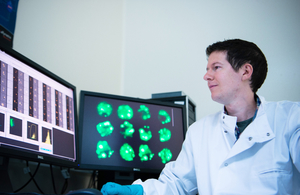News story
A scientist at the Defence Science and Technology Laboratory (Dstl) has revealed promising results during research study to improve antibiotic based therapies.

Using a bacterial disease found in the tropics, Dstl scientist Adam Taylor has been working with Burkholderia pseudomallei, a bacterium that causes the disease melioidosis. This disease currently kills almost 90,000 and infects an estimated 165,000 people every year, symptoms including abscesses and pneumonia are common. Treatment of this disease is complex and lengthy; the bacterium is resistant to several antibiotic therapies.
The research is in two parts: phase 1 is researching how well existing antibiotics work, and phase 2 is improving the effectiveness of these antibiotics by specifically targeting them to infected immune cells using antibodies. This approach has the potential to reduce side effects, increase antibiotic effectiveness, increase specificity and reduce overall antibiotic use during therapy.
Adam Taylor said:
This work is absolutely crucial, we all know that antibiotic resistance is increasing all the time and the amount of new antibiotics cannot keep up with the pace of bacteria becoming resistant, so the global urgency is on to find new ways of treating antibacterial diseases.
I am among only a few scientists currently carrying out this research with this particular disease and I’ve already seen some really promising results. During the studies, I have captured data that shows we can improve how well the existing antibiotics used to treat this disease perform by linking them to an antibody.
It is thanks to the world-class facilities at the Dstl Porton Down site that Adam is able to carry out his research. The bacterium is extremely hazardous, however Dstl’s state-of-the-art high containment facility and its cutting edge equipment ensure this work can be carried out.
The research requires specialist imaging equipment and techniques. For example, a confocal microscope can be used to look inside the cells of the immune system, and by using florescent macrophage cells to simulate a bacterial infection the researcher can see what is happening inside the cells more easily.
Adam added:
It’s really exciting when you see positive results, sometimes you don’t believe what you’ve seen, so you do the test again, but it’s a really good feeling when you have discovered something that could really make a difference.
Adam’s PhD research is sponsored by the London School of Tropical Medicine, with initial results from the study expected for release in 2021.
Published 10 June 2021
Follow this news feed: HM Government





